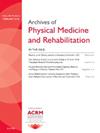解读 Fugl-Meyer 评估方案的差异:名义小组共识进程的结果和建议。
IF 3.6
2区 医学
Q1 REHABILITATION
Archives of physical medicine and rehabilitation
Pub Date : 2025-04-01
DOI:10.1016/j.apmr.2024.10.004
引用次数: 0
摘要
目的确定六种上肢福格-迈耶评估(FMA-UE)方案的施测和评分说明之间的差异,并就最佳施测程序达成共识:设计:名义小组共识技术,包括对方案内容的反复独立审查、匿名投票和小组共识会议:在临床实践和研究环境中工作的临床医生通过 Zoom 参加虚拟会议:干预措施:不适用。主要结果测量:在三阶段共识过程中,讨论并分析了对每项 FMA-UE 协议的定性审查以及评分者对一般管理说明(即可能影响许多单个测试项目评分的说明)差异的回应(同意/不同意)。小组共识的先验目标是达成 80% 或以上的一致:结果:有 7/10 份一般管理说明达成了共识。共识小组的建议为研究人员和临床医生总结了 "最佳实践 "一般说明。在一个案例中,我们发现 FMA-UE 最高分和最低分之间相差 21 分,这突出表明了这些方案差异的潜在影响:结论:在中风康复研究中,FMA-UE 施测方案之间的差异会导致不同机构在解释和转化研究结果时出现差异,并限制标准化评估在循证实践中的认知价值和应用。本次名义小组共识的结果为制定具有凝聚力的 FMA-UE 建议以进行更广泛的传播和审查迈出了第一步。本文章由计算机程序翻译,如有差异,请以英文原文为准。
Interpreting Variations in Fugl-Meyer Assessment Protocols: Results and Recommendations From a Nominal Group Consensus Process
Objective
To identify variations among administration and scoring instructions of 6 upper extremity Fugl-Meyer Assessment (FMA-UE) protocols and to achieve consensus regarding optimal administration procedures.
Design
Nominal group consensus technique comprised of iterative independent reviews of protocol content, anonymous voting, and group consensus meetings.
Setting
Clinicians working in clinical practice and research settings participated in virtual meetings via Zoom.
Participants
Ten experts in stroke rehabilitation and administration of the FMA-UE contributed to the interprofessional consensus group.
Interventions
Not applicable.
Main Outcome Measures
Qualitative reviews of each FMA-UE protocol and rater responses (agree/disagree) regarding variations in general administration instructions (ie, instructions that could affect the scoring of many individual test items) were discussed and analyzed during a 3-phase consensus process. An a priori target of 80% or greater agreement was used to determine group consensus.
Results
Consensus was attained for 7 of 10 general administration instructions. Recommendations from our consensus group summarize “best practice” general instructions for researchers and clinicians. A case example, in which we found up to a 21-point difference between the highest and lowest FMA-UE scores, highlights the potential effect of these protocol variations.
Conclusions
Variations among FMA-UE administration protocols during stroke rehabilitation studies can lead to discrepancies in the interpretation and translation of research findings across institutions and limit the perceived value and uptake of standardized assessments for evidence-based practice. The results of this nominal group consensus provide a first step toward developing cohesive FMA-UE recommendations for wider dissemination and review.
求助全文
通过发布文献求助,成功后即可免费获取论文全文。
去求助
来源期刊
CiteScore
6.20
自引率
4.70%
发文量
495
审稿时长
38 days
期刊介绍:
The Archives of Physical Medicine and Rehabilitation publishes original, peer-reviewed research and clinical reports on important trends and developments in physical medicine and rehabilitation and related fields. This international journal brings researchers and clinicians authoritative information on the therapeutic utilization of physical, behavioral and pharmaceutical agents in providing comprehensive care for individuals with chronic illness and disabilities.
Archives began publication in 1920, publishes monthly, and is the official journal of the American Congress of Rehabilitation Medicine. Its papers are cited more often than any other rehabilitation journal.

 求助内容:
求助内容: 应助结果提醒方式:
应助结果提醒方式:


